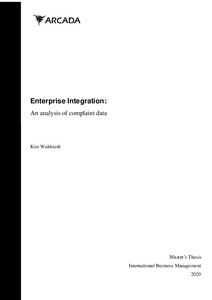Enterprise Integration: An analysis of complaint data
Wahlstedt, Kim Johan (2020)
Wahlstedt, Kim Johan
2020
All rights reserved. This publication is copyrighted. You may download, display and print it for Your own personal use. Commercial use is prohibited.
Julkaisun pysyvä osoite on
https://urn.fi/URN:NBN:fi:amk-2020052814797
https://urn.fi/URN:NBN:fi:amk-2020052814797
Tiivistelmä
Enterprise Architecture (EA) is a strategic instrument used to control and manage the structure and description of an enterprise and its relationships. Facilitating transactions is a key aspect of enterprise architecture. Enterprise Integration (EI) is managing interactions with other enterprises using EA tools and concepts. This thesis is an interpretative case study with aspects of positivism and uses complaint data from a sales organization within an enterprise to explore Enterprise Architecture and Enterprise Integration challenges. With an anchor on adaptive capabilities and related concepts sourced from a literature review. These main concepts being Levels of Capabilities, the Adaptive Loop, shaping the environment and the limitations of EA modelling. It was found different processes have very different success rates and that different teams and customers interacting with or through the same systems may have varying degrees of process outcomes. Specialized, applications and process commitment by eliminating or focusing interaction options with core systems conceivably being key to ensure low failure rates. While having an agreed upon way of changing how things are done. Adaptive capabilities being at the forefront in such a case to ensure competitiveness. Shaping, rather than being shaped by the environment, requires the strategic imperative of learning and sharing to be widely adopted within an enterprise and collaborative networks. A proper balancing of resources and attention between the constructional or future state, with the functional or current state of an enterprise, can be difficult to maintain. Leading to enterprises facing various challenges rather than having the ability to create opportunities for change, with inherent capabilities the enterprise may have already developed.
